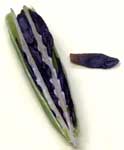|
|
|
 Plants
reproduce sexually by the production of seeds which
contain genetic material from the male (pollen) and
female (pod) parent. Of course, unlike in the animal
kingdom, both parents may be on the same plant or they
may be contributed by two different plants. People
called hybridizers grow new plants from seeds and often
sort through thousands of seedlings to find one that is
worthy of naming and introducing to the gardening
public. Plants
reproduce sexually by the production of seeds which
contain genetic material from the male (pollen) and
female (pod) parent. Of course, unlike in the animal
kingdom, both parents may be on the same plant or they
may be contributed by two different plants. People
called hybridizers grow new plants from seeds and often
sort through thousands of seedlings to find one that is
worthy of naming and introducing to the gardening
public. |
|
|
|



